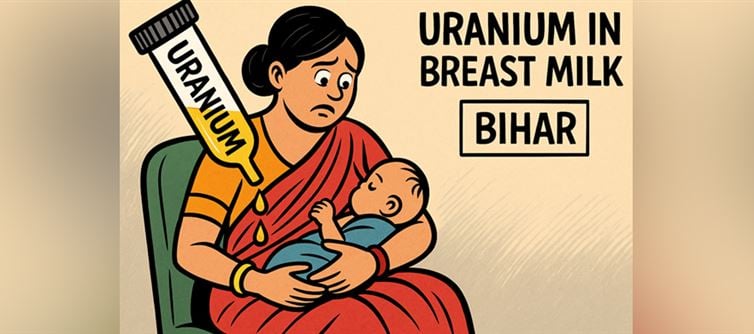
In what may be one of the most unsettling environmental warnings in recent years, a scientific study analyzing breast milk across several bihar districts has revealed detectable uranium (U-238) in every single sample tested. While researchers urge calm — emphasizing that levels remain under international safety thresholds — the fact that 70% of infants show potential non-carcinogenic health risk has sent shockwaves through public health circles.
This is not panic.
This is a wake-up call, exposing a hidden toxic footprint seeping through groundwater, soil, and the very first nutrition infants consume.
1. Uranium Found in 100% of Breast Milk Samples — A Statistic No Parent Wants to Hear
Forty lactating mothers.
Forty samples.
Forty positive for uranium.
This isn’t random contamination — it’s systemic.
The highest district averages were found in Khagaria, while the single highest sample came from Katihar. The radioactive element has quietly entered the maternal food chain.
2. 70% of Infants Show “HQ > 1” — A Signal of Potential health Risk
health Quotient (HQ > 1) means possible non-carcinogenic health impacts.
The risks noted include:
impaired kidney development
neurodevelopmental delays
cognitive issues
reduced IQ
Infants are especially vulnerable because their bodies cannot efficiently eliminate uranium. Even low doses accumulate.
3. Yet the Study Says Actual Impact Is “Likely Low” — Here’s Why
Despite frightening headlines, uranium levels measured (0–5.25 µg/L) remain below the WHO’s provisional 30 µg/L limit for drinking water.
Dr ashok Sharma explains:
Most uranium consumed by mothers is excreted via urine
Only trace amounts enter breast milk
Breastfeeding must not be discontinued
The threat exists — but panic is not the solution.
4. How Did Uranium Enter Bihar’s Homes? It’s Everywhere, and Mostly Invisible
Uranium occurs naturally in rock and soil. It enters groundwater through:
granite leaching
mining runoff
coal burning
phosphate fertilisers
industrial waste
bihar is not alone — uranium contamination has been identified in 151 districts across 18 states in India.
5. india Isn’t the Only Country Battling This Issue
Elevated uranium levels have been documented across:
Canada
U.S.
Finland, Sweden, Switzerland
U.K.
Bangladesh
China
Pakistan
Korea and Mongolia
Mekong Delta nations
This is a global water crisis, not an isolated indian problem.
6. Groundwater Exposure Is the Real Enemy — Not Breastfeeding
Stopping breastfeeding would cause far greater harm.
Decades of research show:
Breast milk provides immunity
prevents infections
safeguards neurological development
protects long-term health
The contamination source must be targeted — not the mother-infant bond.
7. The True red Flag: Bihar’s Groundwater Vulnerability
Only 1.7% of Bihar’s groundwater has tested uranium-positive so far — but that’s enough to infiltrate the food chain.
Experts fear these districts may be early signs of a larger environmental trend.
8. This Study Is Just the Beginning — Heavy Metal Screening Nationwide Is Next
Researchers plan to test for:
pesticides
industrial pollutants
arsenic
lead
mercury
The early findings are already unsettling — past studies show these metals in indian breast milk.
9. india Needs a Geochemical Map, Not Another Crisis
This study exposes an urgent national need:
groundwater mapping
contamination threshold monitoring
filtration infrastructure
rural water safety programs
long-term infant health tracking
Without action, this could evolve into a generational health burden.
🔥 BOTTOM-LINE PUNCH
Bihar’s uranium finding is not a disaster — it’s a warning.
A reminder that India’s groundwater crisis isn’t underground anymore.
It’s in homes, in mothers, and in their infants.
The science says the immediate danger is low — but the long-term stakes are enormous.




 click and follow Indiaherald WhatsApp channel
click and follow Indiaherald WhatsApp channel